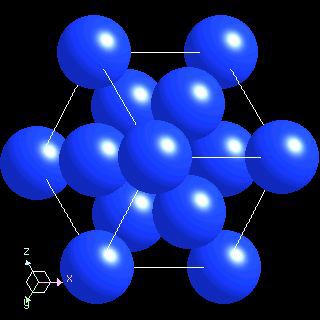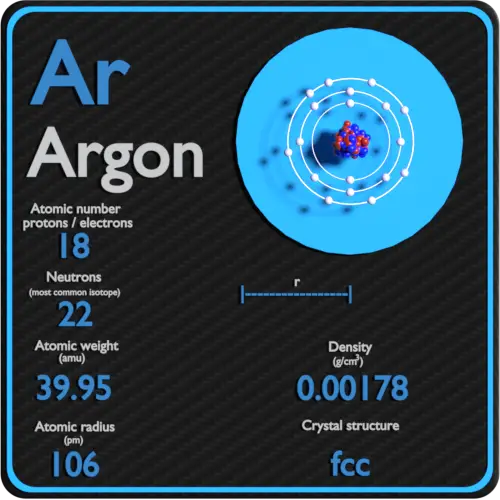Atomic Number of Argon is 18.

Chemical symbol for Argon is Ar. Number of protons in Argon is 18. Atomic weight of Argon is 39.948 u or g/mol. Melting point of Argon is -189,4 °C and its the boiling point is -185,9 °C.
Argon (Ar) exists as a colourless, odourless gas and is chemically inert. It has the atomic number 18 in the periodic table and belongs in Group 18, the Noble Gases. It is a non metal with the symbol Ar. Argon, abbreviated Ar, is element number 18 on the periodic table, making it the third-lightest of the six noble gases behind helium (atomic number 2) and neon (number 10). As befits an element that flies under the chemical and physical radar unless provoked, it is colorless, odorless and tasteless. The 40 refers to the mass number of the isotope. The atomic number of argon is 18, and every isotope of argon has an atomic number of 18. The atomic number gives the number of protons in an atom. Each element has its own distinct atomic number and number of protons.
» Boiling Point» Melting Point» Abundant» State at STP» Discovery YearAbout Argon
Argon is a gas without color and odor, which is one of the noble gases and is totally not reactive with other elements of the Periodic Table. The name of this chemical element originates from the Greek word meaning idle. There is some argon in its pure form in the atmosphere of our planet (estimated to be a little less than 1 per cent) but it has no high biological importance. Argon turns light violet when electricity passes through it. It is used in welding as well as in light and fluorescent bulbs. Also, argon is used to fill up space between two panes of the double glazed windows.

Uses of Argon
Argon, inert gas with the symbol Ar, is used in radio tubes, Geiger counters, fluorescent tubes, and incandescent light bulbs. It is also used in double-glazed windows to fill the space between the panes. And it is used in the production of some metals like titanium, uranium, and zirconium.

Argon can be used in neon lights, heat-treating processes, scientific research, medicine, and 3-D printing too.
Compounds with Argon
- HArF: Argon fluorohydride
- ArH+: Argonium
- MgAr+: Magnesium argide
Properties of Argon Element
| Atomic Number (Z) | 18 |
|---|---|
| Atomic Symbol | Ar |
| Group | 18 |
| Period | 3 |
| Atomic Weight | 39.948 u |
| Density | 0.0017837 g/cm3 |
| Melting Point (K) | 83.8 K |
| Melting Point (℃) | -189,4 °C |
| Boiling Point (K) | 87.3 K |
| Boiling Point (℃) | -185,9 °C |
| Heat Capacity | 0.52 J/g · K |
| Abundance | 3.5 mg/kg |
| State at STP | Gas |
| Occurrence | Primordial |
| Description | Noble gas |
| Electronegativity (Pauling) χ | no data |
| Ionization Energy (eV) | 15.75962 |
| Atomic Radius | 71pm |
| Covalent Radius | 97pm |
| Van der Waals Radius | 188 |
| Valence Electrons | 8 |
| Year of Discovery | 1894 |
| Discoverer | Ramsay and Rayleigh |
What is the Boiling Point of Argon?
Argon boiling point is -185,9 °C. Boiling point of Argon in Kelvin is 87.3 K.
What is the Melting Point of Argon?
Argon melting point is -189,4 °C. Melting point of Argon in Kelvin is 83.8 K.
How Abundant is Argon?
Abundant value of Argon is 3.5 mg/kg.
What is the State of Argon at Standard Temperature and Pressure (STP)?
State of Argon is Gas at standard temperature and pressure at 0℃ and one atmosphere pressure.
When was Argon Discovered?
Argon was discovered in 1894.
Key Difference – Argon vs. Oxygen
Argon and Oxygen are two chemical elements in the periodic table. They are both gaseous elements, where Argon is in the noble gas family and Oxygen is from chalcogen group in the periodic table. Argon is an inert gas whereas oxygen is a very reactive gas. Oxygen is one of the most abundant elements on this planet while Argon is one of the most abundant noble gases. Argon is produced when high purity oxygen is manufactured. They have relatively close boiling points, but their chemical properties are very different from each other. As you can observe the differences between Argon and Oxygen are numerous. This article attempts to provide you with a clarified understanding of the differences.

What is Argon?
Argon (Ar) is a member of a special family; they are called “rare”, “noble” or “inert” gases. All of the gases in this family have a totally filled outermost shell and their chemical reactivity is almost zero. Argon is a monatomic, colourless, odorless, tasteless and non-toxic gas. Argon is slightly soluble in water. Its abundance in the atmosphere is nearly 0.934% by volume. Argon is considered as the most abundant inert gas. All the members of noble gas family emit light when they are electrically excited; in this case Argon produces a pale blue-violet light.
What is Oxygen?
Oxygen can be considered as one of the most abundant element on the earth. About 21% of free elemental oxygen is present in our atmosphere. In addition, it is combined with other compounds such as water and minerals. Even our human body functions using oxygen and it contains 65% of oxygen by mass. Oxygen naturally occurs as diatomic gaseous molecules, O2 (g). It is a colorless, tasteless and odorless gas with its unique chemical and physical properties. The density of oxygen is greater than air and has a very low solubility in water.
The chemical reactivity of oxygen is very high; it reacts with nearly all elements under different conditions, except noble gases and some of less reactive metals. Oxygen is the most reactive element next to fluorine (F).
What is the difference between Argon and Oxygen?
Properties:
| Property | Argon | Oxygen |
| Atomic number | 18 | 8 |
| Electronic configuration | 1s² 2s² 2p63s² 3p⁶ | 1s² 2s² 2p⁴ |
| Boiling point | –185.9°C(–302.6°F) | -182 °C (-297 °F) |
| Melting point | -189 °C (-308 °F) | -218 °C (-361 °F) |
Heaviness:
Argon: Argon is 1.4 times as heavy as air; it’s not breathable as oxygen and can cause suffocating by setting in the lower parts on the lungs.
Oxygen: Oxygen also denser than air, but it is a light weight gas that is breathable.
Uses:
What Is Atomic Number Of Argon
Argon: Argon is an inert gas even at high temperatures, and for this reason, it is used in some critical industrial processes such as in the manufacturing of high quality stainless steel and in producing impurity free silicon crystals for semiconductors. It is widely used as an inert filler gas in light bulbs. It remains un-reactive even when the bulb is heated to high temperatures.
Oxygen: Oxygen is widely used in metal industry with acetylene and other fuel gases for metal cutting, welding, melting, hardening, scarfing, and cleaning. Gaseous oxygen or oxygen enriched air is used in the steel and iron manufacturing, in the process of chemical refining and heating to remove carbon, and in the oxidation reaction.
Petroleum industry also extensively uses oxygen as a feed to react with the hydrocarbon to produce chemicals such as aldehydes and alcohols.
Image Courtesy:
Number Of Protons In Argon
1. Electron shell 018 Argon – no label By commons: User: Pumbaa (original work by commons:User:Greg Robson) [CC BY-SA 2.0], via Wikimedia Commons
2. Electron shell 008 Oxygen (diatomic nonmetal) – no label By DePiep (Own work) [CC BY-SA 3.0], via Wikimedia Commons
Symbol And Atomic Number Of Argon
Related posts:
